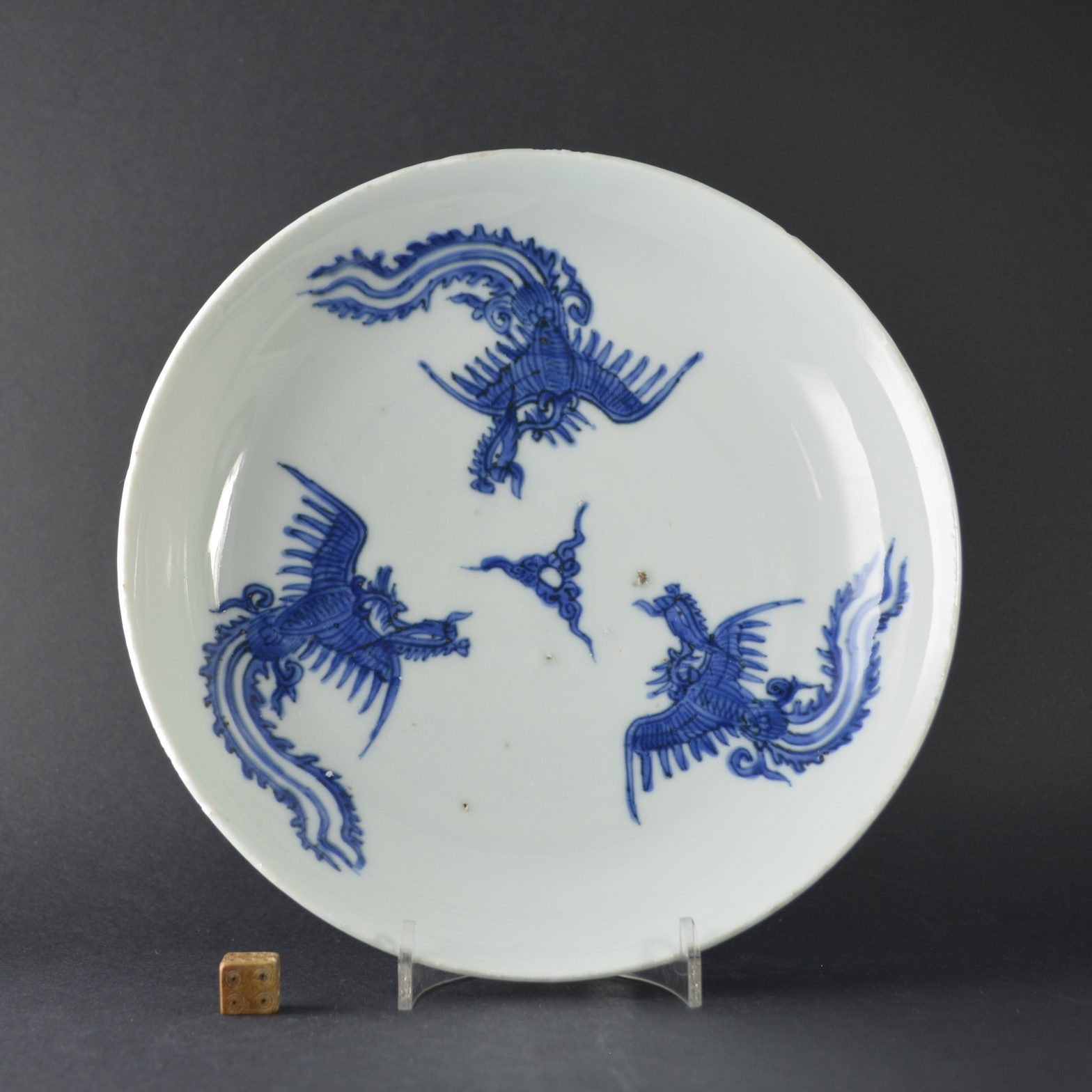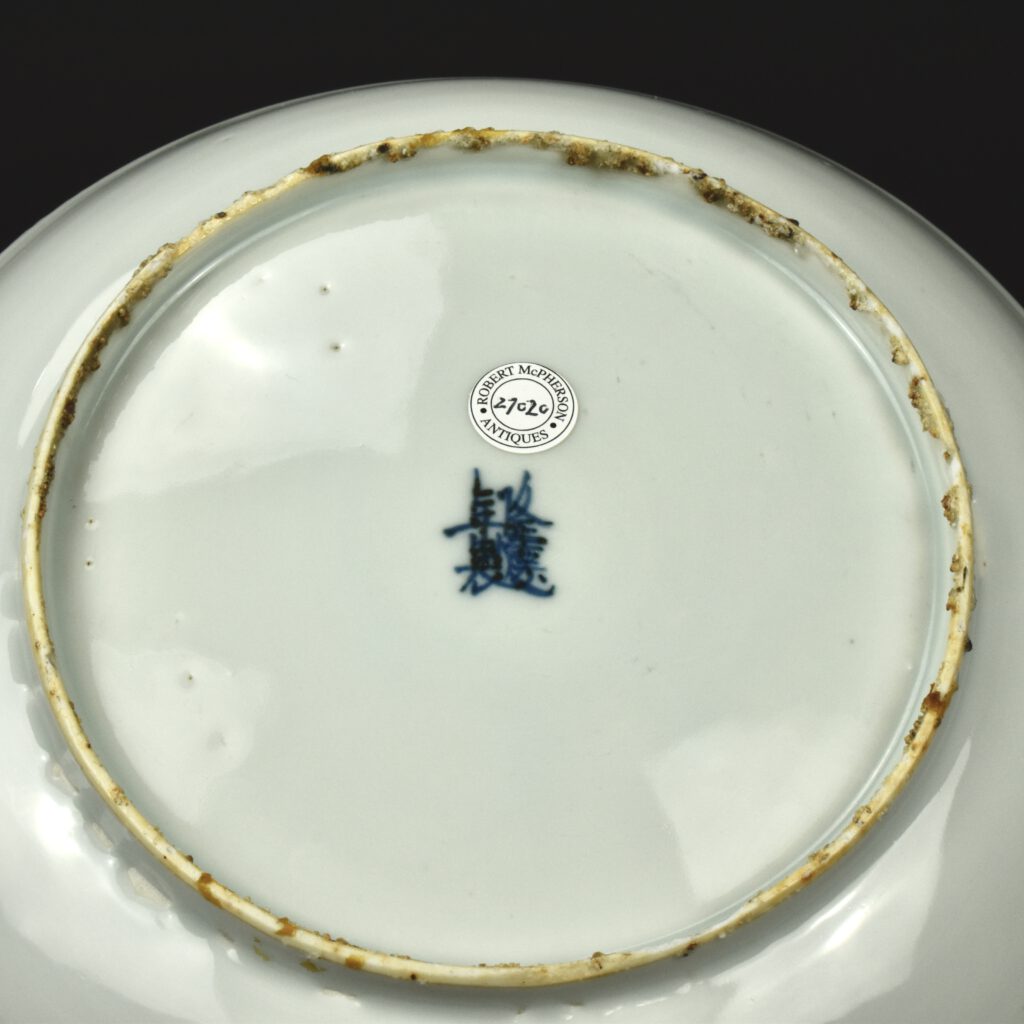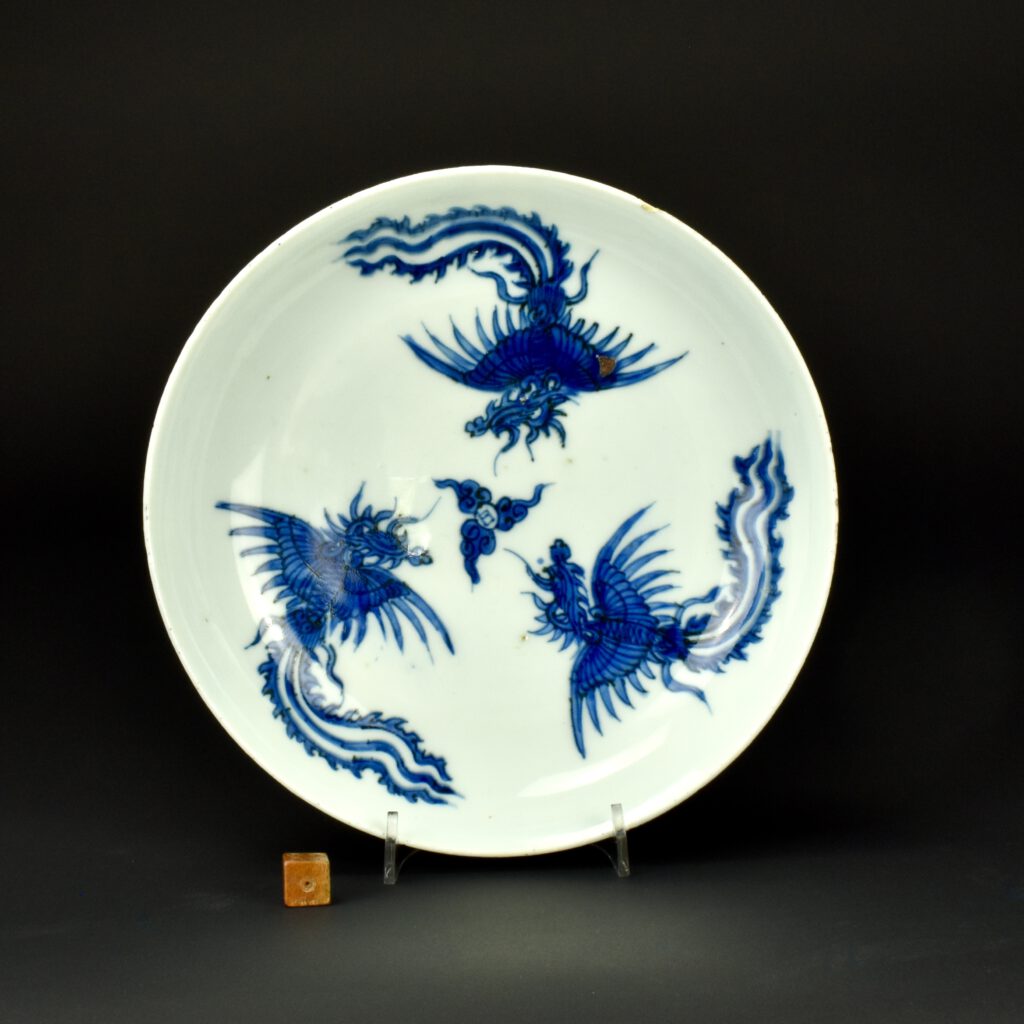
A Rare Longqing Mark and Period Porcelain Dish, Ming Dynasty 1567 – 1572
A Rare Ming Porcelain Dish, Longqing Mark and of the Period 1567-1572. The saucer-shaped dish of shallow form is decorated in a strong cobalt blue with three phoenixes around three clouds and the sun at the center. The base has a small under-glaze blue Longqing mark (1567-1572). It is tempting to think of all Imperial Porcelain being of the very highest quality, but this is not always the case. Firstly, there were differing qualities of porcelain produced depending on who the ceramics were made for, not all Imperial orders ended up on the emperor’s table. Some pieces were made for less important buildings within the Forbidden City, others were made as tributes or gifts. Large numbers of more ordinary pieces might be commissioned. While other more sophisticated pieces would be very produced in very limited numbers for the emperor’s private use. The quality also depended on the degree in which the emperor cared about ceramics, and indeed sometimes Emperors had more pressing things on their mind, like uprisings and wars. The present example is imperial but might not have been used by the emperor. This dish is important in that it ties production to a very specific point in time, something that would be very difficult to establish without the Longqing mark dating it to 1567-1572, a mere six years. See below for another Longqing dish of this size and shape with a Longqing six-character mark from our Sold Archive. Next to it is an almost identical Ming blue and white dish which is non-imperial, that has a seal-mark. The two dishes are of the same quality. Jiajing was known to place imperial orders with non-imperial kilns, simply because the imperial kilns couldn’t keep up with the orders. So, it makes sense that the present dish was also an imperial order carried out at a public kiln on behalf of the emperor Longqing.
See Below For More Photographs and Information.
SOLD
- Condition
- There is a poorly filled rim chip with some scratching to the glaze, the back of which has a glaze crack. The dish doesn't sit flat as the base is curved out. A large piece of kiln grit one one of the phoenix. A very small amount of fritting.
- Size
- Diameter - 19.5 cm (7 3/4 inches)
- Provenance
- N/A
- Stock number
- 27020
Information
A Longqing Mark and Period Dish (left) Together with Another Example with a Seal Mark.
Robert McPherson Sold Archive - 25258 and 25259.
Both Pieces are from the Same Private English Collection.
Left - 25258. Right - 25259
A Longqing Mark and Period Dish 1567 - 1572 - As above (left).

Christie's New York
New York
21 - 22 March 2013
Sold for $8,125
Longqing Emperor of China 1567 - 1572 :
Longqing whos personal name was Zhu Zaiji (朱載坖), was the 13th emperor of the Ming dynasty 1567 to 1572. He was initially known as the Prince of Yu (裕王) from 1539 to 1567 before he became the emperor. His reign name Longqing, means "great celebration".
After the death of the his father Jiajing (1522-1566), Longqing inherited a country in disarray after years of mismanagement and corruption. Realising the depth of chaos his father's long reign had caused, the Emperor Longqing set about reforming the government by re-employing talented officials previously banished by his father. He also purged the government of corrupt officials namely Daoist priests whom the Jiajing Emperor had favoured in the hope of improving the situation in the empire. Furthermore, the Longqing Emperor restarted trade with other empires in Europe, Africa and other parts of Asia. Territorial security was reinforced through the appointment of several generals to patrol both land and sea borders. This included the fortification of seaports along the Zhejiang and Fujian coast to deter pirates, a constant nuisance during the Jiajing Emperor's reign. The Longqing was able to repulsed the Mongol army of Altan Khan, who had penetrated the Great Wall of China and reached as far as Beijing. A peace treaty to trade horses for silk was signed with the Mongols shortly thereafter.
The Longqing Emperor's reign, which was not unlike that of any previous Ming emperor, saw a heavy reliance on court eunuchs. One particular eunuch, Meng Cong, who was introduced by the Longqing Emperor, Gao Gong, came to dominate the inner court towards the end of the emperor's reign. Meng Cong gained favours by introducing Nu Er Huahua, a female dancer of ethnic Turkish origin, to the Longqing Emperor, whose beauty was said to have captured the ruler's full attention. Despite initial hopeful beginnings, the Longqing Emperor quickly abandoned his duties as a ruler and set about pursuing personal enjoyment. The emperor also made contradictory decisions by re-employing Daoist priests that he himself had banned at the start of his reign.
The Longqing Emperor died in 1572 and was only 35. Unfortunately, the country was still in decline due to corruption in the ruling class. Before the Longqing Emperor died, he had instructed minister Zhang Juzheng to oversee affairs of state and become the dedicated advisor to the who was only 10.
The Longqing's reign lasted a mere six years and was succeeded by his son. It was said that the emperor also suffered from speech impairment which caused him to stutter and stammer when speaking in public. He is generally considered one of the more liberal and open-minded emperors of the Ming dynasty, even though he lacked the talent keenly needed for rulership and he eventually became more interested in pursuing personal gratification rather than ruling itself.
The Longqing Emperor was buried in Zhaoling (昭陵) place of burials for the Ming dynasty
(Information from Wikipedia).
Longqing Emperor of China 1567 - 1572















